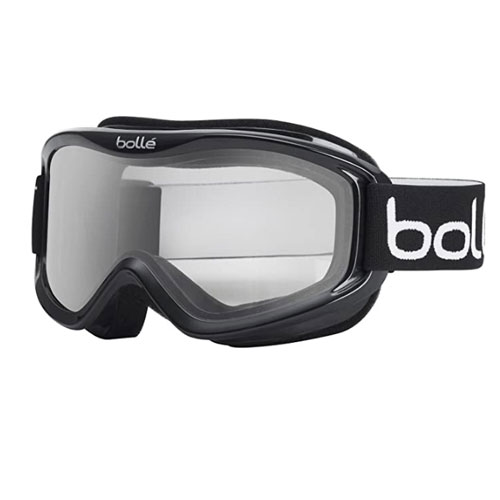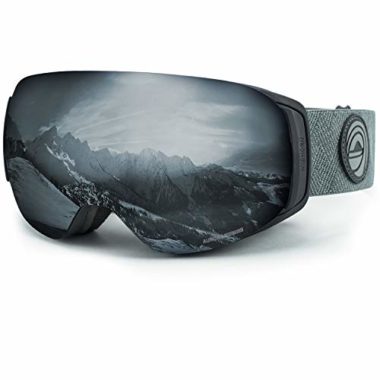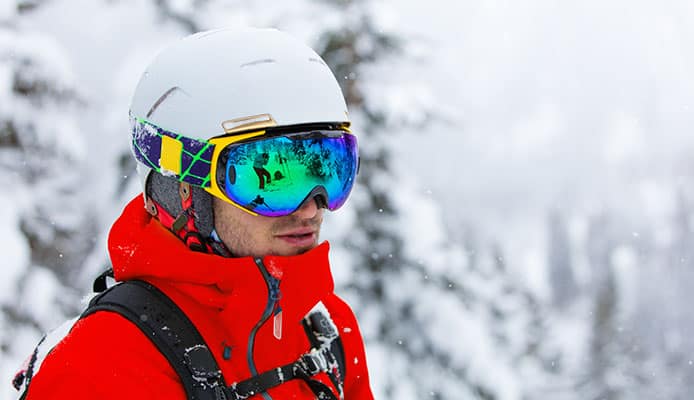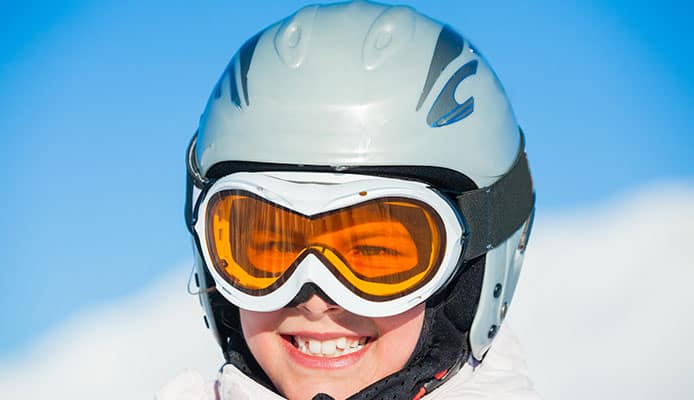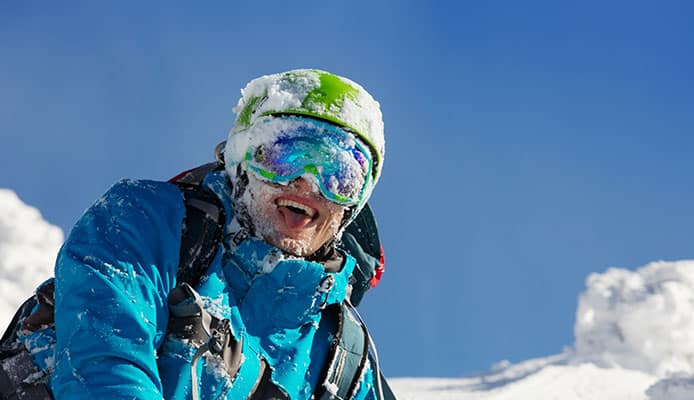
Whether you are a professional skier, or you are on the slopes recreationally, being properly equipped with top-tier gear is essential. Gear is what will make your days on the slopes fun and enjoyable. After getting your ski jacket, snow pants, and gloves, having a ski goggle is probably your most important item in the ski arsenal.
Ski goggles protect the eyes not only from injury, but from other debris, including the wind, snow, and the sun’s ultraviolet rays. Also, they will help you see better, potentially avoid injury, and have a great experience. No matter your level of experience or budget, there is a pair of top rated snow goggles waiting for you to find them. Beginner, intermediate or advanced skiers should definitely try to use the most efficient ski goggle.
With such a wide variety of different styles, lenses, shapes, and colors, how will you know which are the best goggles for you? We at Globo Surfer will do this job for you. In this guide, we’ll show you which goggles are perfect for you. To be sure, read our buying guide and find your best ski goggles:
OUR TOP PICK
Zionor Lagopus
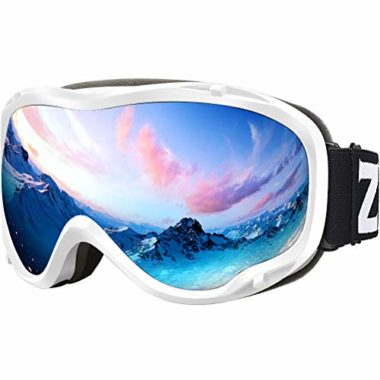
- Stand Out Features - Why We Love It
- Keep you warm
- Anti-wind and anti-fog properties
- Very compatible with helmet
- Guarantees clear field of view at day & night
- Designed with a magnetic lens-swapping tech
Product Weight: 5.6 ounces
Length: 7 inches
Width: 1.4 inches
Thickness: 3.5 inches
Colors: 11 color options
EDITORS CHOICE
Outdoor Master OTG
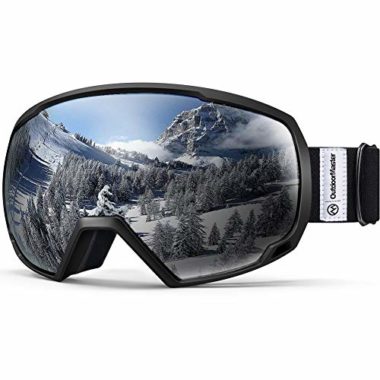
- Stand Out Features - Why We Love It
- Provide safety and comfort
- Have dual-layer lens technology, giving a clear field of view
- Reliable UV protection
- Universally compatible with all helmets
- Regulate sweat & humidity
Product Weight: 5.6 ounces
Length: 6 inches
Width: 1.5 inches
Thickness: 3 inches
Colors: 14 color options
BEST VALUE
Cooloo Wind Resistant
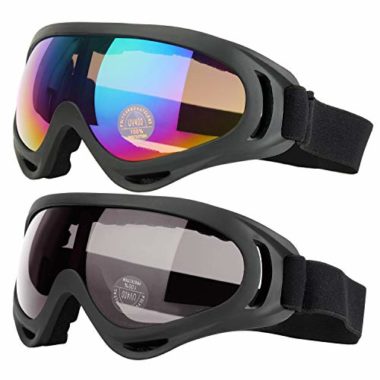
- Stand Out Features - Why We Love It
- Moderately priced
- Guarantee perfect vision both in daytime and nighttime
- Safe, elastic and durable
- Protect the eyes from intense sunshine, strong winds, and thick snows
- Highly compatible and adjustable
Product Weight: 4 ounces
Length: 7 inches
Width: 1.5 inches
Thickness: 2.5 inches
Colors: 8 color options
Bolle Mojo
- Stand Out Features - Why We Love It
- Provide excellent ventilation due to their design
- Double lens prevents condensation from forming
- Embedded with a premium anti-fog layer
- An excellent compromise of quality and value
- Highly versatile pair of budget goggles
Product Weight: 6.4 ounces
Length: 8 inches
Width: 4.5 inches
Thickness: 3.8 inches
Colors: 5 color options
Odoland Double Lens
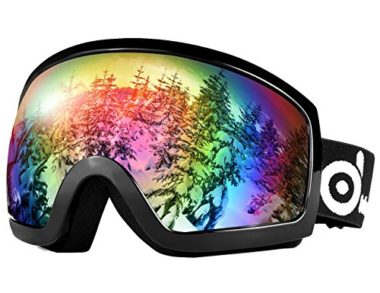
- Stand Out Features - Why We Love It
- Adjustable for all head sizes
- Prevent fogging and condensation effectively
- Versatile for any snow sport
- Portable and durable goggles
Product Weight: 6 ounces
Length: 7 inches
Width: 4 inches
Thickness: 3 inches
Colors: 8 color options
Hongdak Anti-Fog
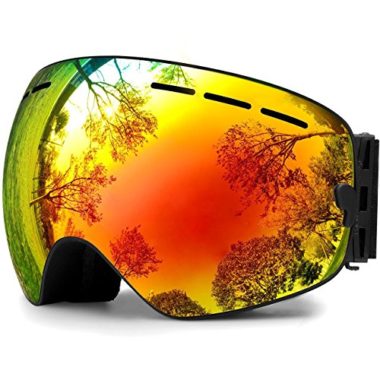
- Stand Out Features - Why We Love It
- High-performance protective lens
- Magnetic & detachable lens system
- Excellent ventilation
- Compatible design
- Durable and compact frame
- Wide and spherical view
Product Weight: 12 ounces
Length: 6 inches
Width: 3 inches
Thickness: 2 inches
Colors: 13 color options
Zionor Spherical Lens
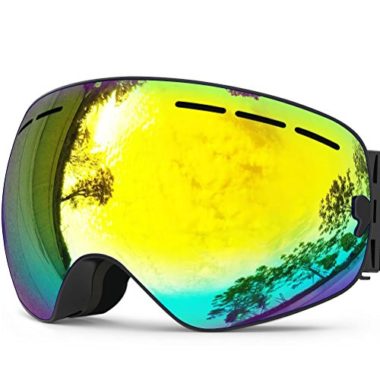
- Stand Out Features - Why We Love It
- Have superior anti-fog tech
- Protect against all sorts of light conditions
- Multiple spare lenses available
- Excellent two-way ventilation
Product Weight: 6.4 ounces
Length: 6.5 inches
Width: 3 inches
Thickness: 2 inches
Colors: 9 color options
Akaso Compatible
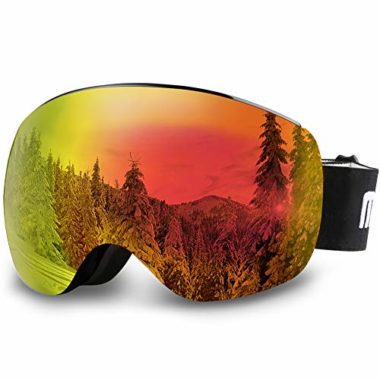
- Stand Out Features - Why We Love It
- Innovative interchangeable lens
- Anti-fog and crisp vision
- Highly compatible
- Soft and comfortable inside
- Durable and resilient frame
Product Weight: 18 ounces
Length: 7 inches
Width: 3 inches
Thickness: 2 inches
Colors: 8 color options
Copozz Magnetic Anti-Fog Ski Goggles
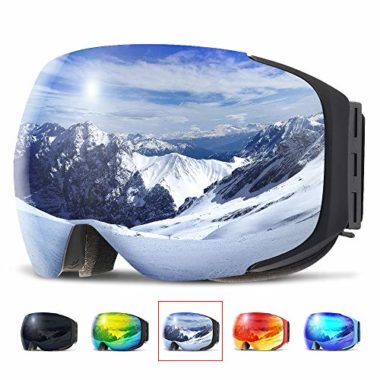
- What Makes These Goggles Stand Out
- Have magnetic lenses and frameless design
- Protect from UV rays and have anti-fog properties
- Compatible with all helmets and can easily fit over your glasses
- Anti-scratch, wear-resistant
Product Weight: 7.2 ounces
Length: 7 inches
Width: 4 inches
Thickness: 2.5 inches
Colors: 7 color options
How To Choose The Best Ski Goggles – Buying Guide
A pair of great ski goggles are an important item in skiing apparel. They will help you see better, avoid falls and crashes, and protect your eyes from debris. However, choosing the right goggles can be quite an endeavor. There are so many factors that should be considered and it can be a difficult thing to choose the best pair for you. Our buying guide will simplify a lot of things for you. By reading everything in detail choosing the right ski goggles will be easy.
Related Post: How To Choose Ski Goggles
UV Protection
Since the sun will be reflecting off of the snow on the slopes, the UV protection will be absolutely necessary for your eyes. UV radiation is harmful without any filtering. The skin around the eyes is thin and sensitive, so it’s important that you get goggles that provide as much UV protection as possible.
Try to choose goggles with a minimum filter category of 3. This will ensure that your eyes are suitably protected on the slopes. For kids and young adults, a filter category of 2 is better, since it can impede their vision in low light. A pair of quality lenses will offer 100% protection from UVA, UVB, and UVC rays. If you’re willing to pay slightly more for this feature, your eyes will be thankful.
Lenses
With a myriad of key features that you need to consider when purchasing your ski goggles, one of the most important ones is the type of lens. There are three different types of lenses in the goggle world; the difference is in the optical clarity.
Cylindrical lenses are most entry-level lenses, meaning that they curve across your face horizontally, but are flat vertically. This shape is cheaper and easier to manufacture, but can often result in loss of peripheral vision and minor distortion. Some just prefer the look, but the primary reason to opt for a cylindrical lens is the cost. With some advances in lens technology, the negative impacts of cylindrical lenses can be mitigated, but they will still remain second in quality.
Spherical lenses are curved both horizontally and vertically. The curve is intended to mimic the shape of your eyes to give a natural field of vision. The optics of the spherical lens are superior and clearer. With their bubble-like shape, spherical lenses give the goggle a taller profile. While looks are a matter of personal preference, the main reason to choose spherical lenses should be the quality they provide. If you’re willing to pay slightly more, then opt for these ones.
Toric lenses are a third shape that has recently gained popularity. The design is a midway split between cylindrical and spherical lenses – they are both curved vertically and horizontally. They mimic the shape of the spherical lens but are less pronounced and bulky. The advantage of toric lenses is mostly aesthetic. From an optical perspective, toric lenses provide good performance and minimize distortion. They are medium priced
Anti-fog Features
The kind of lenses you use does not matter at all if your ski goggles are all fogged up, to begin with. To start off, make sure to choose a double lens – they are much less prone to fogging than a cheap, single lens. Ventilation comes from both sides, top, and bottom, and the more air moves through the less fogging occurs. Another way to avoid fogging is to avoid overdressing and keep your goggles one during your ski day. Moving goggles to your forehead will cause heat and moisture.
The vast majority of ski goggles have an anti-fog coating on the inside of the lenses. It’s important that you avoid continuously wiping the fog off the inside of your goggles since this can degrade the lens. If you wipe them, make sure to do that with something soft that won’t scratch the lens. Air-drying is the best solution, or you can bring an extra pair of goggles with you. For those with persistent fogging issues, you can find goggles with small electric fans that promote airflow.
So keep in mind to not put the goggles on your forehead and keep the vents open at all times. If they do get fogged, do not wipe them with your glove! Either put them in your jacket pocket or go into the lodge. Also, try shaking them, since this might move enough air to defog them.
Comfort
As with most outdoor gear like helmets and jackets, the level of comfort provided is absolutely crucial. To ensure that the ski goggles are comfortable, make sure to look for a pair with inside foam padding. The quality of the padding differs vastly on goggles. The more you spend, the better the padding. On basic models, the padding is a single-layer foam that is not as comfortable as pricier models. When the price tag gets bigger you’ll find flexible and comfortable insides.
If you plan on skiing only for a few weekends each year, going for a pair of cheaper goggles is perfectly rational. However, if you like spending a lot of time on the slopes you will definitely appreciate the level of comfort with good padding.
Fit
Since you will be probably wearing your goggles for hours at a time, it’s important that they don’t pinch, slide, or cut off your peripheral vision. The vast majority of ski goggles are one-size-fits-all, but they can also come in small, medium, and large sizes. Oversized goggles tend to be for skiers who like to focus their field of vision. If you wear glasses, make sure to get goggles with an extra-deep lens. That’s a much cheaper option than going with prescription lens goggles.
To ensure that the goggles fit properly, check if there are any gaps between the foam and your face. Everything should fit snugly without pressure points. The temple and the nose area tend to be the biggest problems for most skiers, so pay extra attention to how the goggles feel there. If you feel any discomfort, try adjusting the strap before tossing them aside.
Remember that you should also ski with a helmet on. That means that you should look for goggles with larger straps to accommodate. Your helmet and goggles should pair comfortably on your head. If the goggles are too big, it will cause the helmet to slide back and expose your scalp, which might be unsafe.
Additionally, before you purchase the goggles, pay attention to your field of vision. If the goggle is too small it will impact your vision from side to side and up and down. You will get the most accurate picture of how the goggle feels if you try the goggles with your ski helmet on. That way you are sure to get a well-fitting pair of skiing goggles.
Lenses Tint
The tint of the lens can help you see better in many situations. Even though each brand is different, colors like yellow, pink, and blue are best for flat light days when it’s hard to see. For bright days, black, mirrored, and dark lenses are better. Goggles for sunny days should also be calibrated to let in less light, while flat-light or low-light days should allow for more.
Related Review: Ski Goggles For Flat Light
If you like to ski in all types of weather conditions, consider getting a photochromatic lens. These lenses are darker when there are strong UV rays present, making them adaptable and perfect for skiers who like to go from skiing in blizzards to sunny days. Some companies are even creating lenses that specifically adapt to changing conditions that improve contrast and clarity.
Just make sure to choose goggles with removable and replaceable lenses. You can switch out lenses in different tints to see what works best for you in various light conditions. Remember that tins are often a matter of personal preference and what makes you, the skier, more comfortable.
Polarization
Companies are producing specific lens technologies that are designed for harsh and variable conditions. These are the mirrored, polarized, and photochromic lenses, which are a new thing on the market.
Polarized lenses tend to cut down on glare, making it a lot easier to see obstacles on the trail, especially on sunnier days. The sun’s rays reflect light in every direction, and when a ray hits a flat surface, such as snow, the reflected light shines back at your eye and causes glare. This phenomenon can block your vision and not only be comfortable, but potentially dangerous as well. By having this type of lenses you can see a lot more clearly. Also, it helps reduce the harmful effects of UV light.
There are two types of lenses – .75mm lenses and 1.1mm lenses. The first ones are great for everyday activities when you’re not worried about impact resistance. If you have a few extra dollars to spare then the latter may be for you. These lenses offer better glare reduction and higher polarization.
So, to put it simply, polarized lenses work to block light rays that travel in certain orientations. This means that reflected light will either be completely eliminated or at least diminished. This means less glare on snow, less glare on the water, and less glare on windshields. Your eyes won’t have to adjust or squint to see – that’s why this type of lenses reduces eye strain and fatigue. The only downside is that polarized lenses tend to be priced higher than non-polarized lenses.
Fixed Lenses vs. Interchangeable Lenses
Depending on if the lenses are replaceable within the goggle, lenses are divided into two groups – fixed and interchangeable.
Fixed lens goggles are cheaper than interchangeable ones. If you’re opting for a fixed-lens pair, make sure that the type is perfectly versatile with all weather conditions. You should not look to buy a pair of fixed lens goggles.
Interchangeable lens goggles are fantastic – they give you a lot more flexibility than fixed ones, as long as you’re willing to carry an extra lens in your pack or your jacket. Interchangeable lenses today are improving rapidly. The idea is to be able to quickly release and replace a goggle lens on the fly. This allows the skier to have two or more different lenses at all times to adapt to the changing light conditions. If you plan on spending a good amount of time on the snowy slopes, you need to be prepared for all sorts of weather and light conditions. This is why goggles that allow you to quickly change lenses will come in handy
Having a variety of lenses available can help you maximize visibility and performance throughout each stage of the day. No one type of lens will provide optimal visibility across the full spectrum of lighting and weather conditions. If this feature appeals to you, make sure that the set of goggles you have accommodates easily.
Ventilation
To ensure maximum ventilation, choose a double-lensed pair of ski goggles. With a double-lensed goggle, ventilation comes from all sides – top and bottom, as well as up and down. The more ventilation the goggle has, the better it is. Not only does ventilation drastically reduce fogging, but it also helps to regulate your face’s temperature by improving airflow. This way, your face will not sweat and temperature will be regulated. Heavily ventilated goggles fog a lot less than those with minimal ventilation.
Keep in mind that finding the perfect balance between ventilation and fogging is quite difficult. These are the two biggest problems with most goggles. Goggles with good ventilation will not only keep you fog-free but will also guarantee your comfort and wide view. Also, the level of ventilation depends on the weather conditions you ski in. If you plan on skiing in a place with a lot of sunshine, opt for something with more vents, or else you will sweat profusely. If you are skiing somewhere with freezing temperatures, opt for something with fewer vents. This way your face will not freeze and your goggles will keep the warmth in.
Foam Padding Types
As with most types of outdoor gear such as helmets and backpacks, the type of inside foam padding matters a lot. There have been tons of improvements in the goggle padding industry in recent years. There are multiple types of foam padding, including:
Single-layer foam padding – this is a type of foam padding that older goggles were made with. It’s just one open-cell foam that absorbs sweat but deteriorates over time. It’s remarkably cheap but very low in quality. It’s not recommended even for beginners since most times it feels gross and quite uncomfortable.
Double layer foam padding is slightly pricier and not nearly as good as multi-layered foams. It will also retain more smell and break down quicker. It’s okay for beginners and those who do not spend a lot of time on the slopes.
Multi-layered foam padding is the way to go for modern ski goggles. This type of padding consists of open-cell foam – the first layer, soft foam – the second layer, and absorbent microfleece – the third layer. These layers together make a soft and sweat-resistant goggle seal. Thick foam padding significantly improves your level of comfort.
Today you will rarely encounter a modern goggle than isn’t designed with multi-layered foam padding. Unless you are looking for the absolute cheapest goggle you can find, avoiding poor foam padding is highly recommended. If you plan on skiing only for a few days a year, going for thinly padded goggles is a rational choice. Otherwise, avoid them.
You might also like: What Is The Difference Camber vs. Rocker
Quality
Optical quality refers to the stands to which the lenses and frame of a pair of goggles work together. High optical quality ensures pure vision. When choosing the ideal pair of goggles, you need to take into consideration factors such as weather, terrain, and the activity you wish to do. Make sure to choose an optical quality lens with your chosen light conditions, as well as the type of skiing you wish to embark on. Depending on the properties, the lens can be mirrored and photochromic.
Mirrored lenses do a great job of reflecting light, which means that there is less light coming into the goggle. This is ideal for sunny days when the alpine sky and the snow make a reflective surface. This reflective light is harmful to the human eye. They are also very fashionable and overall look good. Their downside is that they will make your eyes struggle on darker days on the mountain since they block so much light.
Photochromic goggles react to sunlight and darken themselves depending on the amount of light being received. Indoors they turn brighter, outdoors they darken to adjust. If you get immersed in a storm, these lenses will immediately lighten up and make you see well. They are pricey though.
No matter the type of lens, make sure to choose an optical quality lens that will be compatible with the conditions you will be faced with.
Shape
The shape of the goggle defines their look, style, and function. There are a couple of main shapes that affect the way the goggles work – there are flat and spherical shapes.
Flat shapes of goggles are compatible with cylindrical lenses, they are curved horizontally and flat vertically. They offer good, but not exceptional, performance at an affordable price point.
Spherical shapes of goggles match with spherical lenses. They are curved in all directions and are shaped as if they were cut from a part of a sphere. They are more expensive but give the lens better peripheral vision and less optical distortion. This is better for a clear view.
Field of Vision
Field of vision, or FOV for short, is the area you can see with the goggles while your eyes are fixed. Ideally, the ski goggles should enable you to see 180 degrees from side to side. Also, lenses that have an anti-scratch coating are also a suitable option since they will keep your field of vision clear and free from scuff marks that would otherwise appear on the lenses. Anti-scratch and anti-fog coating will guarantee that you have a clear view.
Also, in these recent, your goggles with a large frame have noticeably grown in popularity. Wide and tall lenses with a thin or rimless frame don’t impede your view and enhance peripheral vision, avoiding “tunnel vision” that was inherent with older goggles. More visibility makes for a safer day on the mountain. Premium goggles with a large-size frame are almost as good as not wearing a goggle at all. Your goggles should do a nice job retaining good visibility with a low profile design, whether they are spherical or cylindrical lenses.
FAQs
Q: Who Should Buy Ski Goggles?
Anyone who will be skiing or snowboarding should buy at least one pair of ski goggles. The goggles will protect your eyes from flying debris, including snow and ice, as well as other potentially dangerous things, such as harmful UV rays. These could negatively impact both your vision and the delicate skin around your eyes.
Keep in mind that the sun’s rays reflect off of the snow too, so even on an overcast day, the potential for sunburn and eye damage is great while skiing or snowboarding – this is exactly why we talked about the benefits of polarized goggles. Additionally, goggles for skiing will protect your eyes from the effects of the wind. Since your eyes are a sensitive part of the human body, nature’s elements can do harmful things, such as dryness and chafing. If there are leaves and other natural debris in the air, the goggles will keep them out of the skier’s eyes. Impact-resistant goggles will be very protective in case of a fall as well.
So, as long as you enjoy winter sports, skiing goggles will definitely be of benefit to you.
Q: What Are Photochromic Lens Ski Goggles?
Photochromic goggles have lenses that automatically change color in response to the amount of light available. They are a great choice for skiers who don’t want to switch out lenses depending on whether the sky is overcast or sunny, or if they are skiing at night. Since they adjust automatically to the lighting conditions, this gives them a very wide VLT range (visible light transition). VLT is the amount of light that is allowed to pass through a lens. In the brightest sun, you need low VLT, and for night skiing you need a lot of VLT.
Related Review: Night Ski Goggles
To grossly simplify, photochromic means “auto-darkening”. When you wear them indoors they will turn brighter, or even bright clean. When outdoors, on sunlight, they will slowly darken to adjust to the bright sunlight. They are a popular tech being used on glasses and they are quite convenient for skiers. They can be quite pricey, however, but they are often worth the versatility and flexibility they offer the skier.
Q: Can You Use Sunglasses Instead Of Ski Goggles?
While sunglasses do provide some UV protection, they are definitely not a suitable alternative to goggles for skiing. Firstly, the amount of skin that they cover is inadequate and incomparable – goggles will cover the upper cheeks and the forehead, which is a lot higher than typical sunglasses. Secondly, they do not have nearly the same level of impact resistance that goggles do. They are also not compatible with helmets.
Sometimes it does come to a matter of personal preference. Sunglasses can sometimes be a well choice if the weather is sunny and the conditions are good. Even if you do decide on skiing with sunglasses, it is always recommended that you take your goggles with you, just for the added security. Many skiers like to wear sunglasses and switch to goggles only if the conditions deteriorate. Putting it shortly, you should choose goggles for skiing instead of sunglasses when you have the choice.
Q: What Does VLT Mean For Ski Goggles?
VLT, or Visible Light Transmission, is the amount of light, measured on a scale from 0% to 100%, which is allowed to pass through the goggles’ lens. In the brightest sun, you may want a lens with as little as 10% VLT. To optimize your view for night skiing, you should get around 90% VLT. There are generally some variations depending on the manufacturer, but lenses are often 15-40% VLT for bright to normal conditions and 40-70% VLT for cloudy and snowy days. Other factors like polarization and lens tint also matter.
Also, the level of VLT often changes the lenses’ color. At the low end of the VLT spectrum are colors such as blacks, gray, and blues, which are designed to block out most light and therefore are the darkest. Toward the middle for partly cloudy days are purples, reds, and greens, which color how the snow and mountains look significantly. For overcast and gray days, you will find lenses that are much clearer than the first two categories and come in very light shades, such as yellow or blue.
Q: What Are The Perfect Goggles For Beginners?
Beginners should try to keep their costs low since they’ve probably already gotten their expensive skis, boots, and other equipment. However, make sure that the quality is not compromised for the price – a good helmet and goggles are not optional, they are necessary.
However, you might happen to not enjoy skiing as much as you thought you would, so this way you will avoid wasting a lot of money. So, look out for a high quality spherical or cylindrical goggle. The Outdoor Master OTG Goggles on our list will be a great choice for any beginner.
Q: What Is The Best Factor To Look For In A Ski Goggle?
Firstly, you should not look to compromise any features of a goggle at the expense of other ones. However, if you are in a position where compromising cannot be avoided due to any reasons, make sure to opt for a pair of goggles with an excellent peripheral view and fog-proof features. When skiing, the most dangerous accidents on the slopes occur from skiers colliding with one another. While good goggles can’t prevent this, a wide peripheral view can help you notice your surroundings better.
To put it shortly, sacrifice comfort for the field of vision and clarity. Crashes can always happen, so it’s better to be safe than sorry.
Q: Are Interchangeable Lenses Worth It?
Overall, they are a worthy choice. Once you pick the perfect pair of goggles for you, being able to easily change the lenses to adapt to all sorts of conditions helps you get a lot more mileage out of them. Fixed lensed goggles lack the versatility that interchangeable ones do not. It’s just too difficult to find a pair of fixed lensed goggles that will serve you all year round, in all conditions.
Using the right lenses is vital to staying safe. Dark lenses on overcast days will make the snow look flat and can easily hide bumps or rollers that can send you off balance, or into other skiers, trees or rocks. By getting interchangeable lenses you can keep the spare lens in your inside coat pocket, protecting the goggle case from being scratched. If a storm rolls in, head to the nearest lodge and swap out the lenses! Interchangeable lenses are an overall great choice.
Q: Are There Differences In Women’s Ski Goggles?
If you look at the goggle and the frame, women’s goggles are no physically different from men’s. However, they tend to be a little different in styling. Generally speaking, women’s goggles are a bit smaller. Also, they most often feature lighter colors in the frame and lenses. Women’s-specific models have more “feminine” colorways with a slightly narrower frame. In general, goggles are a unisex piece of gear.
If you see a men’s pair of goggles that you like, there’s really no reason why you shouldn’t buy it. As long as the style, size, fit and comfort are appealing to you, nobody cares if they’re men’s goggles. Same goes for men – if you see a pair of women’s goggles you like and they fit nicely, who cares what gender they’re supposed to be. When you get in the store, try a few pairs and don’t be afraid to try both men’s and women’s goggles. There’s nothing you can lose.
Q: Can I Buy Replacement Straps For My Goggles?
Since the elastic strap on a pair of good goggles is usually one of the first parts to wear out with use, most skiers would like to be able to replace their straps. Unfortunately, the vast majority of goggles on the market have straps that cannot be replaced. You can still, however, hang on to the lenses and just replace the frame altogether. Sometimes, you can even reach out to the company and ask for a frame – they will probably charge you a lot lower than if you were to buy a new goggle set altogether.
If neither of the previously mentioned options is possible, your only option is buying a pair of new goggles. You will have extra lenses from your last pair as a backup, but you will have to buy the entire new set. This can be a little pricey, but you should not worry at all since goggles need to be worn for a serious amount of time before the elasticity of the strap wears out.
Q: What Lens Color Should I Use?
If you plan on skiing for more than just two weekends a year, you cannot get away with purchasing one pair of lenses with one color. The most optimal lens for a bright day will not be the best option for stormy conditions, vice versa. Ultimately, the lens color you should use really depends on the conditions you will be using it in. Along with the color, the two main factors to consider when buying a lens color is VLT (Visible Light Transmission) and contrast technology. These two factors have a lot of influence on the lens color.
In low light conditions, you will want a goggle that features a yellow, amber or light rose base. These lens colors offer the highest VLT, usually ranging from 35-60%, which will allow as much light in as possible and provide you with enhanced contrast throughout those darker days. Also, they will probably be having a mirror coating that protects you from glare and reflection.
For those who prefer to hit the slopes on brighter days, a darker lens will be your best bet. Clarity of view will not be a problem for you, but glare can seriously impede your vision. Since dark lenses have a lower VLT – between 5% and 18%, less light will pass through your lens. The best lenses for bright conditions on the mountain are either a plain dark grey lens or a dark brown / rose, coupled with a heavy mirror. These darker colors are mirrored, which helps deflect glare, while the grey, brown or rose color gives added contrast, which is important for seeing definition in the snow.
If you are an all-weather skier who’d rather enjoy his / her times on the slopes than worry about interchanging your lenses, we recommend going with a universal lens. These goggle lenses feature a happy-medium of VLT, which will allow the goggle lenses to perform fairly well in nearly all conditions. To get such a lens, look for the following colors – medium copper, rose, or brown tint. Usually, these colors are very lightly mirrored, or they’re not mirrored at all. The previously mentioned colors will give you some contrast vision for the overcast conditions, while still providing some brightness protection for the sunnier days. They’re your best bet no matter what Mother Nature throws at you.
Globo Surf Overview
When you’re looking for the perfect goggles for you, it is important to know what you will be using them for. Do you typically find yourself on night trips or multi-day adventures? How long will you be wearing your goggles? Will you be wearing them for extended periods at a time, or you’re in for a one hour trip? Do you expect bright and sunny weather, or will a nasty storm appear? Do you like skiing once a year, or are you in there for more than one season? Answering these questions will help you decide which pair of skiing gloves is the best one for you.
The best ski goggles on our list have been tried and tested with the ultimate stamp of approval. They are trusted amongst the best professionals in the market, and they’re guaranteed to hold up in all of your activities. A pair of good quality goggles will provide warmth, dexterity, style and tons of convenience. Knowing what qualities to look for in a pair of goggles will save you a lot of time, effort and money when determining which is the most efficient goggles for you.
More Snow Ski Gear Reviews:
- Avalanche Shovels
- Cameras For Skiing
- Ski And Snowboard Waxes
- Ski Bindings
- Ski Glove Liners
- Ski Knee Braces
- Ski & Snowboard Backpacks
- Ski Hats
- Cross Country Skis
- Ski Helmets
- Women’s Ski Jackets
- Ski Gloves
- All Mountain Skis
- Womens Ski Gloves


